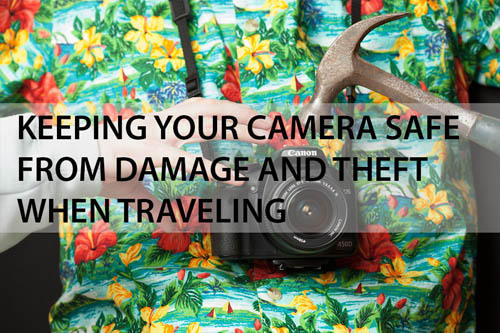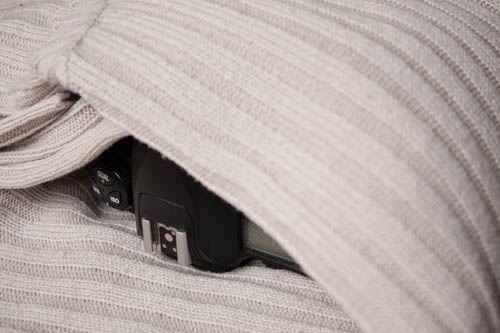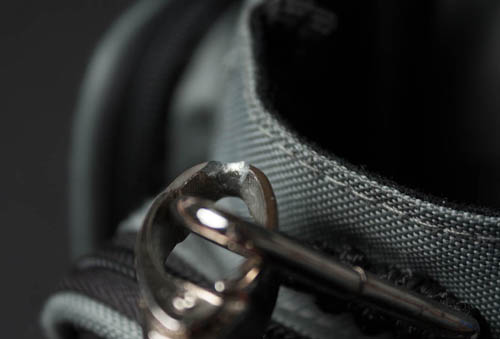Keeping your camera safe from damage and theft when traveling
When traveling on vacation, the vast majority of us will want to bring a camera to capture what we see and experience. Many of us want to capture high quality photos, and be ready for most photographic situations we come across. This can mean bringing an expensive camera and accessories with you on vacation.
In this article I want to look at how you can protect your expensive photography gear when traveling, from both damage and theft.
Packing photography gear
When packing your photography gear, ensure that it is well padded to absorb any knocks and bumps. This goes for both packing your gear for travel, and when carrying it around with you.
If you're bringing a number of photography items with you (e.g. a DSLR camera and a couple of lenses), then a photography bag can be a good choice. These are padded with foam and also use foam inserts you keep your gear organized and protected.
For smaller amounts of equipment, you might not want to bother with a photography bag. Instead you can just wear your camera round your neck when traveling. Or if you would prefer to pack it away, you can wrap it in soft clothing to protect it.
Traveling with photography gear
When traveling, whether it be by bus, plane, or train, it is best to keep your photography equipment with you. Pack your clothes and everything else in your checked luggage, but keep your camera (and lenses if applicable) in your carry on.
This way you can always keep an eye on your bag. If your camera and other gear are in your checked luggage, the gear could be stolen from the luggage, the case could get lost, or the whole case might even be stolen.
The only exception I would make to this rule is if you're bringing a tripod with you. Most tripods are too large to bring in carry-on luggage. You can buy special travel tripods that pack up very small and will fit in a carry-on.

The MeFoto series of tripods are popular for travel
However, personally I don't worry about having to leave my tripod in luggage that is out of sight. Most thieves prefer smaller high value items that they can discreetly pop in a large jacket pocket. They are less likely to bother with something bulky and heavy like a tripod.
I would recommend packing your tripod in the same case as your clothes though, rather than packing it separately. If you just check your tripod in a standard tripod bag, then it stands out more as luggage of potential value. Whereas if it's packed in your suitcase covered with clothes, a thief will need to actively check through your case to find it.
Carrying camera gear
As I said earlier, it is a good idea to carry your camera in a bag with some padding so that if the bag gets bumped or knocked, your camera won't get damaged. But when considering a bag, you may also want to think about how difficult that bag will make it for anyone wanting to steal your camera.
The first point is that carrying a bag that looks like a camera bag is more likely to attract thieves, as it screams 'expensive photography gear inside'. You can get plenty of camera bags that don't look especially like a camera bag. Or you can convert a standard bag into a camera bag with a padded insert.
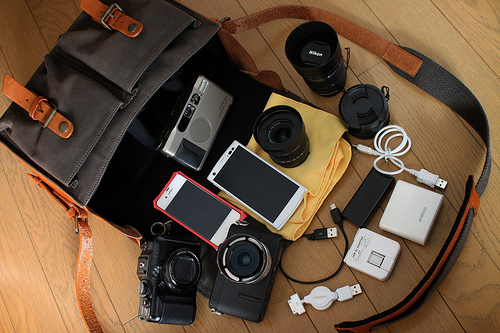
What's in your bag? by MIKI Yoshihito on flickr (licensed CC-BY)
Carrying a tripod around with you seems to mark you out as a 'serious' photographer. So this could make you more of a target, as it could make thieves think you will be carrying high value professional photography gear. A travel tripod that can fit inside a standard bag would be a solution to this issue.
If you use a backpack for carrying your camera, it will be easier for a thief to access it without you realizing, since you cannot see it. In busy areas your bag may be constantly bumped by passers by, and you might not be able to notice someone accessing the bag.
On the other hand, a thief opening someone's backpack is more likely to draw the attention of others (who will hopefully stop the thief!) than a thief standing next to someone and dipping their hand into their shoulder bag. Overall a backpack is probably not really any more problematic than other types of bag, they both have issues you should be aware of.
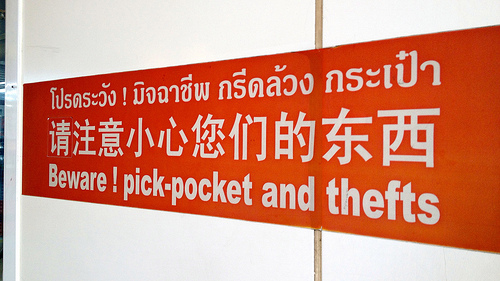
Beware! pick-pocket and thefts, Bangkok by David McKelvey on flickr (licensed CC-BY)
The good thing about using a proper photography bag in terms of theft prevention is that it reduces the likelihood of someone slashing the bag to get at the contents. A thief would need quite a long and sharp knife to get through both the outer layer of the bag and the protective foam layer.
If you decide to go with a shoulder bag, then resting one arm over the bag by your side can be a good way to deter thieves. Opening the bag without you noticing is going to be tricky if your arm is in the way. Make sure the bag has a top flap that can be secured down though, otherwise a thief may be able to dip their hand in the bag from the end.
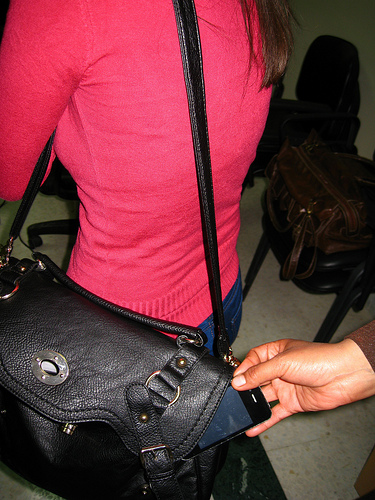
vol d'un portable by Formation04 on flickr (licensed CC-BY-ND)
Bags that close using velcro can be both useful and problematic in terms of preventing theft. Velcro is quite noisy when pulled apart, so this will immediately alert you if someone is trying to open your bag. On the other hand a flap secured by velcro can typically be pulled open faster than one using clips, so a thief may still be able to quickly open and snatch an item from your bag. Ideally use a bag that has a combination of zips and velcro or clips.
An alternative to using a bag is to use a shooting vest. This is a specially designed vest with large pockets for storing photography equipment such as lenses etc. in. These normally feature inside pockets as well as outside zipped pockets under a velcro secured flap. Difficult for a thief to access easily.

But for protecting your gear from knocks and scrapes, these vests aren't so great. They don't usually contain much if any padding. Lint build-up in the pockets can also find its way into your camera and lens. The main issue though is that if you get too hot wearing the vest and take it off, then accessing your gear stored in the vest is going to problematic.
If you're using your camera on a neck strap, then I would suggest wearing the strap diagonally across your body, so it goes under one arm. If you wear it just round your neck, then it makes it easier for a thief to just grab the camera and pull it off over your head.
I also find that the camera bumps around on my chest quite a bit if I wear the strap only around my neck. This isn't very comfortable, and while it is unlikely to damage the camera, it's not going to do it any good either.
Something you might not think about is the quality of the bag / strap you are using to carry your camera. When you consider the value of your camera you may be hanging from your neck strap or loading into your bag, it makes sense to pay a little more for a good quality item.
If you're using the same bag you've used for a long time, then you should be fine, since you know the bag is up to the task. But if you're looking at purchasing a new bag or camera strap, try to find some reviews to check the quality first. If they are given, check the weight limits for any strap or bag you are considering. You want the item to be able to handle your gear without risk of breaking.
When on vacation, I would also suggest regularly checking the loops and straps on your bag / strap. Make sure straps aren't fraying or coming apart. Make sure metal loops aren't bending. Make sure stitching on straps isn't coming loose. And make sure plastic parts aren't snapping.
Protecting your gear from damage while in use
While I've never used it myself, it's worth being aware that you can purchase camera armor for some camera models. This is a silicone skin that wraps round your camera, while letting you still access all the buttons and controls. It will prevent scratches to the camera and also provide slight shock absorption if you knock or drop the camera.

A lens hood can reduce flare as well as protecting your lens. If you drop your camera or knock it against something, the hood will protect the front element of the lens.
If you find that a lens hood makes your camera too large for your liking, or you are using a super-wide lens where a lens hood is not practical, you can consider using a UV filter instead. This is a glass filter that screws onto the end of your lens, so you need a lens that supports filters (some compact cameras do not).
The filter protects the front element of the lens, so only the filter will get scratched or dirty, not the actual lens. You can read more about UV filters here: Why use a UV Filter?. UV filters are usually more expensive than lens hoods. (If you're looking at expensive manufacturer branded lens hoods, you can usually buy third party hoods that are just as good but a lot cheaper).
Insurance
When taking out travel insurance, check what is covered. The policy may cover a large amount overall for theft, but only allow a small maximum value per item stolen. Some policies also have restrictions on how much your can claim for electronic goods.
There may also be exemptions against damage depending on how you're using your equipment. For example, if you were using a camera in a waterproof housing in the sea, but the housing leaked and your camera was damaged by sea water, you might find you're not covered. So make sure the policy will cover what you want it to.
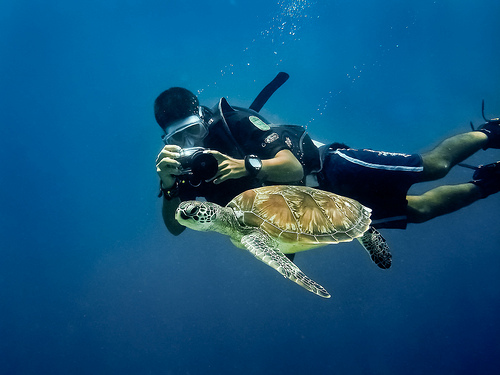
Photographing Turtles by William Warby on flickr (licensed CC-BY)
Whether it is worth the paying the extra to have your photography gear fully covered is something that only you can decide. It depends on factors like how expensive the equipment you have is, how much the extra insurance cost is, whether you're visiting somewhere that crime is a problem, and how you intend using your camera gear.
Bring a compact camera (or phone) instead
One solution that many photographers with DSLR cameras use, is to just take a compact camera on vacation instead of their more expensive camera. While this gives up something in terms of image quality and flexibility, it does mean that you don't need to worry so much about keeping your camera gear safe.
Many compacts produce great image quality in good light. More expensive compact cameras can produce very good quality images and are usable even in low light. These advanced compact cameras do cost quite a bit, but they are also less likely to be attractive to thieves. A thief won't know what model you're using, just that you're using a compact camera, and that they're typically not worth much.
Using a compact camera doesn't mean there's no chance of your camera being stolen - compact cameras still get stolen occasionally. It just makes you less of a target to thieves than if you were using a more expensive looking camera.
Another alternative is to just use your phone. However, unlike a compact camera, smart phones are typically quite attractive to thieves. And the image quality (and focus speed, zoom, etc) is not as good as a dedicated camera.
Finally, if you are confronted by thieves wanting your camera, it is better to hand it over than get stabbed, shot, or beaten up and then have your camera taken from you by force. Thankfully though, this sort of confrontation is extremely rare.
To conclude, there are quite a lot of different options for keeping your camera safe from theft and damage when traveling (and when at home too). The best options will vary between each person, so just try to follow the advice that seems best to you.
